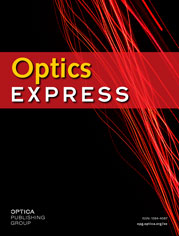Feature Issue of Optics Express
Photonic Technologies for Autonomous Cars
Submission Opens:1 September 2018
Submission Deadline: 1 October 2018
Optics Express welcomes submissions to a feature issue on "Photonic Technologies for Autonomous Cars." Photonic technologies, as used in lidar and laser-sensing-related technologies for self-driving cars, have experienced explosive developments in recent years. There are currently several dozen commercial companies developing components, subsystems, or full systems to enable varying degrees of autonomous driving to meet the future needs of the automobile industry. This feature issue will allow for archival publication of the most recent works in these blossoming fields and provide for broad dissemination in the optics community.
Autonomous vehicles need to monitor every moving and fixed objects in their immediate environments, and lidar plays an important role to attain this goal. There is a fundamental tradeoff between maximum ranging distance and spatial resolution in lidar systems, and lots of research efforts have been dedicated to meeting this challenge, such as high-power laser sources at visible or infrared wavelengths with output beam steering, high-sensitivity/high-resolution detector arrays, ICs for image acquisition/recognition, and advanced packaging to downscale the size of the whole system. In addition to lidar-related technologies, fiber-optic gyros (FOGs) and FOG-based inertial measurement units (IMUs) form key parts of the integrated sensor systems essential for controlling autonomous cars with high accuracy. In contrast with the hybrid package for these above-mentioned photonic systems, the research about photonic integrated circuits (PICs), which should be the ultimate solution for low-cost and miniaturized modules, has now blossomed into several start-up companies. Overall, a complex photonic supply chain is gradually forming to satisfy the strong demand from the automobile industry.
On the other hand, in order to handle such a huge amount of real-time and high-resolution image data in an autonomous car, high-speed data transmission through an in-car fiber network is highly desirable. Compared with the bulky coaxial cable, optical fiber has the advantage of low weight and immunity against electromagnetic interference, which are important issues, especially for electric vehicles (EVs).
Topics for the feature issue will include, but are not limited to:
- Light source, detectors array, passive optics components, and their package in lidar systems
- The operability and reliability of lidar systems
- Smart laser headlights
- Optical-fiber-based systems and components for high-speed, in-car data communication
- Fiber optics gyro and sensors for highly accurate autonomous car performance
- Photonic integrated circuits for applications of lidar and gyro
- Other passive and active sensing approaches relevant to autonomous cars
All papers need to present original, previously unpublished work, and will be subject to the normal standards and peer-review process of the journal. The standard Optics Express Article Processing Charges will apply to all published articles.
Please prepare manuscripts according to the author instructions for submission to Optics Express and submit through OSA's electronic submission system, specifying from the drop-down menu that the manuscript is for the Feature Issue on Photonic Technologies for Autonomous Cars.
Feature Editors
Jin-Wei Shi, National Central University, Taiwan (Lead Editor)
Jiun-In Guo, National Chiao Tung University, Taiwan
Manabu Kagami, Toyota Central R&D Labs, Inc., Japan
Paul Suni, Lockheed Martin Space, USA
Olaf Ziemann, Polymer Optical Fiber Application Center, Germany

